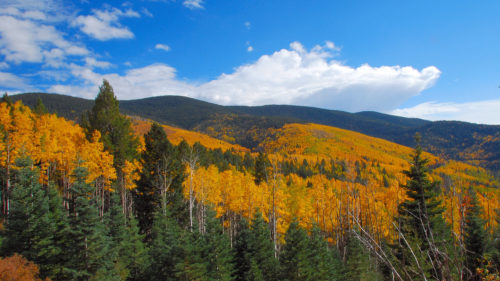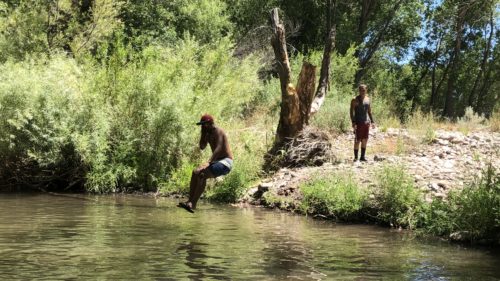(This story first appeared in the Spring 2014 Outdoor Reporter)
New Mexico anglers got some unexpected good news in mid-April – the state Attorney General’s Office declared that all New Mexico fishing streams are public domain, and therefore open to fishing and wading, regardless who owns the adjoining property.
That’s in stark contrast to Department of Game and Fish regulations and decades of tradition, which assume that a landowner can prohibit anglers from fishing or wading in streams that run through their property and that anyone wading in the stream without permission is trespassing.
Fishermen should tread cautiously, however. The AG’s opinion is just that – an opinion, not a law or a regulation. As of late April state fishing regulations remained at odds with the opinion and the Department had not yet explained how it will handle the question of trespass on public streams this summer. Department officials have said they will issue a statement in early May that set the stage for how this matter plays out. But the issue may not be fully resolved until the courts rule or the Legislature clarifies state law.
(Editor’s note: As of mid-July, neither the Department of Game and FIsh nor the State Game Commission had issued any comment or direction on the stream access opinion.)
Despite the uncertainties, “This is great news for New Mexico anglers,” said NMWF Executive Director Garrett VeneKlasen. “For too many years, fishermen have been barred from waters that, according to our state Constitution, belong to all New Mexicans. This could take some time to sort out and anglers need to be patient. But we are confident that public property rights will prevail and that our children and grandchildren will have full and unfettered access to all our fishing waters.”
“This issue is of paramount concern for all New Mexicans,” he continued. “Public domain is a birthright for both living and future generations of sportsmen and women, the same as our Constitutional rights. If we allow these rights to be eroded, we risk other fundamental rights regarding public lands and even fish and wildlife resources.”
Legal basis goes back decades
The Attorney General’s Office based its opinion on two key sources: water law as established by both the Territorial Legislature in 1907 and the New Mexico Constitution of 1912, and a 1945 state Supreme Court case.
Before New Mexico was a state, the Territorial Legislature declared that all waters “belong to the public and are subject to appropriation for beneficial use.” Five years later the New Mexico Constitution adopted similar language, that “every natural stream, perennial or torrential, within the state of New Mexico, is hereby declared to belong to the public ….”
In 1945, the New Mexico Supreme Court spelled out anglers’ rights. In a landmark case known as Red River Valley, a company that sought to exclude fishermen from Conchas Reservoir argued that because it owned the surrounding property the lake itself should be off-limits to the public. The court disagreed, saying that “the waters in question were, and are, public waters; and that the [landowner] has no right of recreation or fishery distinct from the right of the general public.”
The company appealed, but the high court not only reaffirmed its initial decision, it concluded that the streambed leading into Conchas Reservoir was open to the public, too, even though the landowner owned both sides of the stream.
And it added this: “The small streams of the state are fishing streams to which the public have a right to resort so long as they do not trespass on the private property along the banks.”
The Attorney General’s Office, in April, underscored the point: “The public’s right to use public waters for fishing includes activities that are incidental and necessary for the effective use of the waters. This includes walking, wading and standing in a stream in order to fish. Although, as Red River makes clear, a person may not trespass on private property in order to gain access to public waters, a person using public waters to fish, including incidental activities such as walking, wading or standing in a stream bed, is not trespassing.”
As clear as that seems, however, the opinion also says that neither state fishing laws approved by the Legislature nor the fishing regulations adopted by the State Game Commission recognize or address the public’s right to fish in streams that cross private property.
The trespass regulation says only that: “It shall be unlawful to hunt, capture, take, attempt to take, or kill any game animal, furbearer, game bird, or game fish on any private property … without possessing written permission from the landowner ….”
But while neither law nor regulation mentions streams or streambeds, a warning in the Game and Fish rule book flatly declares that anglers are trespassing if they enter private land, including “stream and river bottoms located in private property” – a statement not backed up by regulation or statute and in direct conflict with the 1945 Supreme Court decision.
Rep. Luciano “Lucky” Varela of Santa Fe, a 27-year veteran legislator and chairman of the powerful Legislative Finance Committee, requested the AG’s opinion to help clarify the question of stream access for all. Varela told NMWF that he has asked the Department of Game and Fish and the State Game Commission to respond to the AG’s opinion and to adjust their regulations accordingly.
When asked whether he thought additional legislation was needed to shore up New Mexicans’ right to fish in public streams, he said, “No. It’s pretty much been ruled on by the [Supreme] Court and opined by the Attorney General, so the law is the law.”
The Game Commission could bring its regulations into accordance with the Supreme Court decision and the AG’s opinion at any time. The Commission did not address it at meetings in May or June, and as of mid-July the stream access question was not on the agenda for its August meeting.
In the past, the Commission has relied on AG opinions to revise its regulations, take legal action or adjust its operating procedures. Most recently, the Department followed an Attorney General’s opinion that resulted in successfully challenging the Terk injunction.
‘Long row ahead,’ other advocates say
If the access question can be clarified, New Mexico would join a handful of states where the public has broad access to stream beds, including Montana, Idaho, Oregon and Texas. But sportsmen involved in Montana’s access fight warn that New Mexicans may have a long row ahead of them.
Montana’s stream access fight started in 1977 and continues to this day, said John Gibson, a Billings, Mont., sportsman and president of the Public Land and Water Association. Two Butte fishermen filed a lawsuit after a landowner harassed and interfered with anglers and floaters on the Dearborn River. The plaintiffs believed they had a right to use the Dearborn because it was a “navigable” stream.
Eventually the Montana Supreme Court, relying on the federal definition of navigability as well as the state constitution, sided with the fishermen. The court found that because the state owned the riverbed and held it in trust for the public, the public had a right to float, swim or wade on such waters and to portage around obstacles. A companion case also was decided in favor of the public.
The Montana Legislature soon approved the historic Stream Access Law, which had broad support from not only anglers and boaters, but also farmers, ranchers and landowners, Gibson said. When that law passed in 1985, it was instantly the strongest law in the West protecting public access to streams, and the gold standard by which other states could measure their own access.
Since then the Montana law has been challenged on numerous fronts, in both state and federal courts, but it survived each assault, Gibson said. In one case, the 9th District Court of Appeals upheld the constitutionality of the law and the U.S. Supreme Court declined to hear the appeal.
Utah has had a similar bumpy road, but with a different outcome. In 2008, the Utah Supreme Court recognized the public’s right to walk on a streambed, regardless who owned the land – much like the courts decreed in Montana and New Mexico. But the Utah Legislature quickly passed a law that prohibits recreational water users – anglers, swimmers, boaters, hunters and others – from touching the bottom on a privately owned streambed.
The Utah Stream Access Coalition has been fighting the Utah law in court and in the legislative arena since it went into effect in 2010. Coalition President Kris Olson, who said he was “just a guy sitting on a trout stream” when the battle began, said stream access is directly linked to the broader assault on public property rights being waged throughout the nation.
“The truth of the matter is that you guys [in New Mexico] are getting involved in a much larger issue, which is the privatization of our public resources,” he said. “There’s this constant kind of push and pushback around the country of people trying to expand their private property rights at the expense of the public, and if we don’t stand up and push back, we’re going to lose.”
Olson urged New Mexico to avoid the long, multi-million-dollar legal battles waged in states like Utah and Montana, and instead adopt sensible legislation that follows the state constitution yet protects private property rights – essentially the model settled on in Montana, Idaho and elsewhere.
But even if New Mexicans have years of legal and legislative battles ahead to establish permanent access to our public streams, it’s worth the effort, said Montana’s Gibson.
“Be prepared for a long hard fight, but think of what you’ll accomplish,” he said. “Here in Montana we feel very proud that we have been part of something that will benefit generations to come, and you can do that too, by just asserting your rights. It isn’t everybody that gets that chance. We usually sit back and do nothing. But get in the arena. To hell with ‘em. Be a Theodore Roosevelt of your time.”
New Mexico Wildlife Federation President John Crenshaw said the organization is aware of the difficulties that lie ahead, but that there is no choice at this point but follow the opinion of the state’s top legal authority, the Attorney General’s Office.
“The Federation has been fighting to protect our public property rights for a century, and we’re not going to quit now,” he said. “Our streams, like our wildlife and public lands, are held in the public trust so that everyone can responsibly enjoy them in perpetuity. This is an opportunity for the sportsmen of our generation to make a difference, and in another 100 years the anglers of New Mexico will be thankful we did.”



